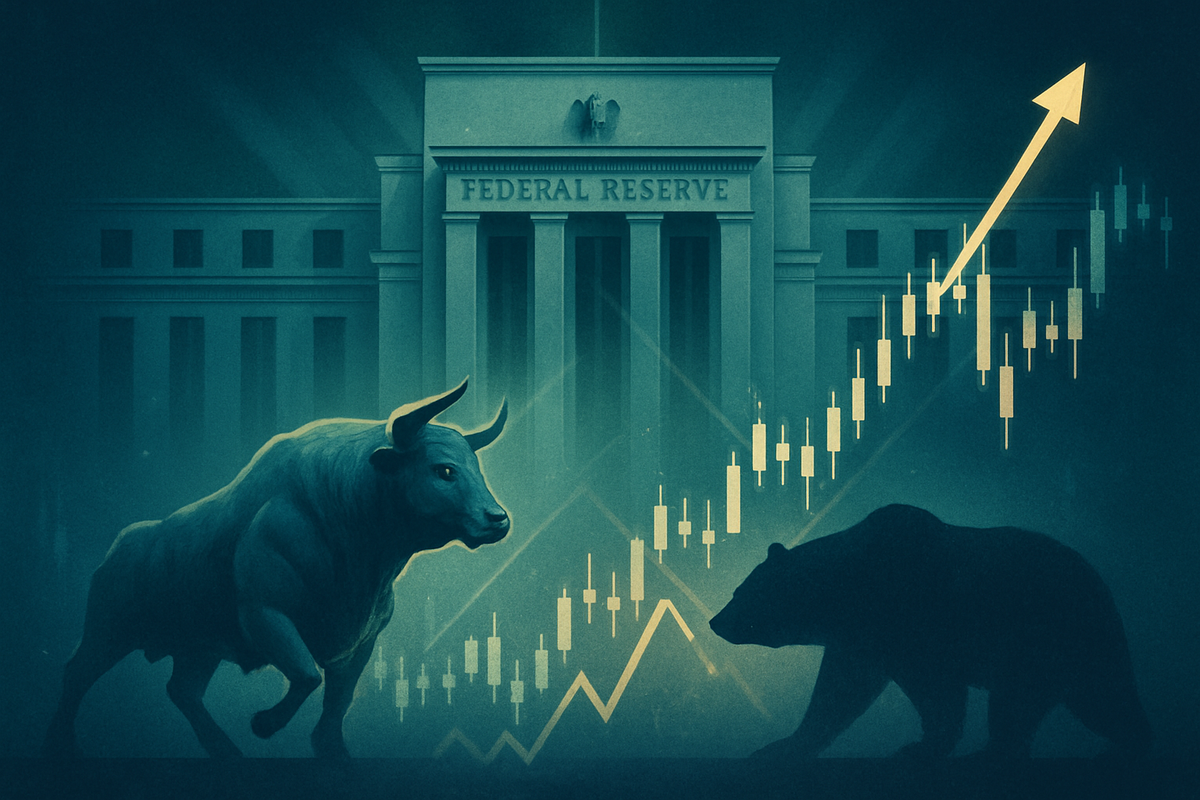
As of October 2025, the Federal Reserve's recent pivot towards a more accommodative monetary policy has sent ripples of optimism through the financial markets, propelling major indices to unprecedented highs. Following a 25-basis-point interest rate cut in September, the first of the year, investor sentiment has largely shifted to "risk-on," buoyed by reduced borrowing costs and a perceived commitment from the Fed to support economic stability. This strategic move by the central bank aims to navigate a delicate balance between achieving maximum employment and taming inflation, while carefully managing emerging risks to the economic outlook.
However, beneath the surface of record-breaking performance, a nuanced landscape of economic jitters and selective market retreats persists. While the broader market celebrates, certain sectors and individual companies are experiencing heightened scrutiny, indicating that not all segments of the economy are uniformly benefiting from the Fed's easing stance. The interplay between the Fed's forward guidance, incoming economic data, and geopolitical factors continues to shape investor caution, creating a complex environment where opportunities and challenges coexist.
The Fed's Dovish Pivot and Market's Enthusiastic Response
The recent actions of the Federal Reserve have been the primary driver of market sentiment and performance in the latter half of 2025.
In September 2025, the Federal Open Market Committee (FOMC) made a significant move by lowering the target range for the federal funds rate by 25 basis points, settling it between 4% and 4.25%. This decision marked a notable shift from a period of holding rates steady for the initial eight months of the year, signaling the Fed's response to moderating economic activity, a slowdown in job gains, and a slight uptick in the unemployment rate. While inflation remains somewhat elevated, the Committee prioritized addressing rising downside risks to employment.
This rate cut was widely interpreted by the market as a "risk management cut," as characterized by Federal Reserve Chair Jerome Powell, aimed at preempting a more substantial slowdown in the labor market. Alongside this adjustment, the Fed has continued its program of quantitative tightening, steadily reducing its holdings of Treasury securities and agency debt and mortgage-backed securities, a move intended to normalize its balance sheet. The market has reacted with significant enthusiasm, with the third quarter of 2025 witnessing substantial gains across the board. The S&P 500 (^GSPC) advanced 8.1% in Q3 and 3.6% in September, pushing its year-to-date gains to 14.8%. The Nasdaq Composite (^IXIC) outperformed, climbing 11.2% in Q3 and 5.6% in September, primarily fueled by the ongoing Artificial Intelligence (AI) boom and robust corporate earnings from mega-cap technology companies. Even small-cap stocks saw a surge in September, buoyed by the prospect of reduced borrowing costs.
The timeline leading up to this moment saw the Fed maintain a cautious stance through early 2025, assessing the impact of previous tightening cycles on inflation and employment. However, as economic indicators began to show signs of softening, coupled with persistent, albeit elevated, inflation, the pressure for a policy adjustment mounted. Key players involved in these decisions include Federal Reserve Chair Jerome Powell and various FOMC members, such as Stephen Miran, Michelle Bowman, and Christopher Waller, who have publicly supported further easing, with some suggesting short-term rates closer to 2%. Initial market reactions were overwhelmingly positive, with equity indices hitting record highs and investor confidence remaining robust, even in the face of a U.S. government shutdown in late September and early October 2025, which caused delays in the release of crucial economic data.
Navigating the Tides: Potential Winners and Losers
The Federal Reserve's easing stance creates a bifurcated market, where certain sectors and companies are poised to thrive, while others face increased headwinds. The prospect of lower interest rates generally benefits growth-oriented companies, particularly those in the technology and communication services sectors, which often rely on future earnings potential and access to cheaper capital for expansion.
Potential Winners:
- Technology and Communication Services: Companies like Apple (NASDAQ: AAPL), Microsoft (NASDAQ: MSFT), Alphabet (NASDAQ: GOOGL), and NVIDIA (NASDAQ: NVDA) are well-positioned. Lower interest rates reduce the discount rate applied to their future earnings, making their valuations more attractive. Furthermore, the ongoing AI boom continues to drive strong corporate earnings for these mega-cap tech giants. Reduced borrowing costs also encourage innovation and investment in these capital-intensive sectors.
- High-Growth Companies: Start-ups and rapidly expanding firms across various industries, which often operate with higher debt levels or require significant capital injections for research and development, stand to benefit from cheaper financing. This could include companies in renewable energy, biotechnology, and emerging software sectors.
- Real Estate and Housing-Related Industries: Lower mortgage rates, a direct consequence of Fed easing, can stimulate demand in the housing market. Homebuilders like D.R. Horton (NYSE: DHI) and Lennar (NYSE: LEN), as well as real estate investment trusts (REITs) focused on residential properties, could see increased activity and profitability.
- Companies with High Debt Loads: Businesses that have accumulated substantial debt may find their interest payment burdens eased, improving their cash flow and financial stability. This could provide a lifeline for some struggling companies or enhance the profitability of others.
Potential Losers (or those facing challenges):
- Financial Institutions (Banks): While lower rates can stimulate lending, a sustained period of low interest rates can compress net interest margins (NIMs) for banks like JPMorgan Chase (NYSE: JPM) and Bank of America (NYSE: BAC). This is because the spread between what they earn on loans and what they pay on deposits tends to narrow.
- Value Stocks (in certain contexts): In a "risk-on" environment, investors often rotate out of traditionally defensive or value-oriented stocks in favor of growth stocks. While not universally negative, some stable, mature companies may see less investor interest compared to their high-growth counterparts.
- Companies Dependent on Strong Consumer Spending (if economic slowdown persists): While the Fed aims to avoid a significant slowdown, if consumer confidence wanes despite lower rates, discretionary spending could suffer, impacting retailers and consumer goods companies.
- Companies with Limited Pricing Power: Businesses that cannot easily pass on increased input costs to consumers, especially if inflation remains somewhat elevated, may see their profit margins squeezed, particularly if economic growth remains moderate.
The Fed's policy, therefore, acts as a selective current, lifting some boats higher while potentially stranding others in calmer waters. Investors must carefully assess individual company fundamentals and sector-specific dynamics to navigate this evolving market landscape.
Broader Economic Ripple Effects and Historical Context
The Federal Reserve's current monetary policy stance extends its influence far beyond individual stock prices, creating significant ripple effects across the broader economy and fitting into overarching industry trends. This easing cycle comes at a time when global economic stability remains a key concern, with central banks worldwide grappling with similar challenges of inflation and growth.
The pivot towards rate cuts by the Fed in September 2025 signals an acknowledgment of moderating economic activity and a desire to avert a more pronounced slowdown in the labor market. This move has positive implications for consumer spending, as lower borrowing costs for mortgages, auto loans, and credit cards can free up disposable income. Business investment is also likely to receive a boost, as cheaper capital encourages companies to undertake new projects, expand operations, and hire more employees. However, the sustained quantitative tightening program, while necessary for balance sheet normalization, acts as a counterweight, ensuring that liquidity isn't excessively abundant, which could reignite inflationary pressures.
The current situation fits into a broader trend of central banks adopting a more flexible and data-dependent approach to monetary policy, moving away from rigid frameworks. Internationally, the Fed's actions have significant implications for global markets. A dovish Fed can weaken the U.S. dollar, making U.S. exports more competitive and potentially easing financial conditions for countries with dollar-denominated debt. Conversely, a stronger dollar (if the Fed were to tighten) can create stress in emerging markets. The recent retreat in European markets due to political uncertainty and valuation reassessments highlights the interconnectedness of global financial systems and how local issues can interact with broader monetary policy signals.
Historically, periods when the Federal Reserve has lowered interest rates at or near all-time highs for the market have consistently led to higher market returns one year later. This provides a historical precedent for the current rally, suggesting that the market's positive reaction is not an anomaly. For example, during similar easing cycles in the past, the stock market has often found renewed vigor as the cost of capital decreased. However, it's crucial to remember that each economic cycle has its unique characteristics. The current environment is marked by lingering elevated inflation, persistent geopolitical tensions, and the transformative impact of AI, factors that distinguish it from previous cycles. Regulatory implications are also at play, as the Fed's actions are closely scrutinized by policymakers and could influence future legislation related to financial stability and economic stimulus.
The Road Ahead: Scenarios and Strategic Adaptations
Looking ahead, the Federal Reserve's trajectory and the market's response will be shaped by a complex interplay of economic data, geopolitical developments, and the Fed's evolving forward guidance. Short-term possibilities include continued market volatility as investors digest incoming economic reports, particularly those related to inflation and employment. The anticipated October and December rate cuts, as projected by J.P. Morgan Global Research and implied by the Fed's median SEP projections, are largely priced into the market. However, any deviation from these expectations could trigger significant reactions.
In the long term, the market faces several potential scenarios. A "soft landing" remains the Fed's ideal outcome, where inflation gradually returns to target without triggering a severe recession. This scenario would likely see continued, albeit more moderate, economic growth and a sustained bull market, especially for companies with strong fundamentals and innovative capabilities. Conversely, a "hard landing" or recessionary scenario could emerge if the Fed's easing proves insufficient to counter economic headwinds, or if unforeseen shocks impact the global economy. In such a case, market retreats would be more pronounced, and defensive sectors might outperform.
Potential strategic pivots for businesses and investors are crucial in this environment. Companies may need to adapt their capital allocation strategies, leveraging cheaper financing for strategic investments while maintaining healthy balance sheets. Those with strong cash flows and less reliance on debt will have greater resilience. For investors, a diversified portfolio with a mix of growth and value stocks, alongside strategic allocations to interest-rate sensitive sectors, could prove beneficial. The ongoing AI boom presents significant market opportunities, but investors will need to be discerning, identifying companies with sustainable competitive advantages rather than speculative plays. Challenges include navigating potential inflation resurgence if the Fed's easing is too aggressive, or a deeper economic slowdown if it's too cautious.
Emerging market opportunities might also arise from a weaker U.S. dollar, making international investments more attractive. Conversely, geopolitical events, such as the U.S. government shutdown in early October 2025, underscore the non-monetary risks that can influence market sentiment and data availability, requiring constant vigilance from market participants.
A Balanced Outlook: Key Takeaways and Investor Vigilance
The Federal Reserve's recent monetary policy adjustments, particularly the September 2025 rate cut and the forward guidance indicating further easing, have undeniably reshaped the financial landscape. The primary takeaway is that the Fed has decisively pivoted towards supporting economic growth and employment, even as it continues to monitor inflation. This shift has largely been a boon for the stock market, propelling major indices to record highs and fostering a "risk-on" sentiment among investors. The technology and communication services sectors, in particular, have been significant beneficiaries, driven by the AI revolution and robust earnings.
Moving forward, the market's trajectory will be heavily influenced by the Fed's continued data-dependent approach. Investors should closely monitor incoming economic data, including inflation reports, employment figures, and GDP growth, as these will guide the FOMC's future decisions on interest rates. While the current outlook suggests further rate cuts in late 2025, any unexpected shifts in these economic indicators could lead to policy adjustments, causing market volatility. The dispersion of views among FOMC members also highlights the inherent uncertainty in predicting the exact path of monetary policy.
The lasting impact of this easing cycle will depend on its effectiveness in achieving a soft landing for the economy. If the Fed successfully navigates these challenges, we could see a prolonged period of moderate growth and a supportive environment for equities. However, risks such as persistent inflation, geopolitical instability, and sector-specific vulnerabilities (as seen with Palantir Technologies (NYSE: PLTR) in early October) warrant continued investor vigilance. A balanced approach, focusing on diversified portfolios, strong company fundamentals, and an awareness of macroeconomic trends, will be paramount for investors in the coming months.
This content is intended for informational purposes only and is not financial advice.






